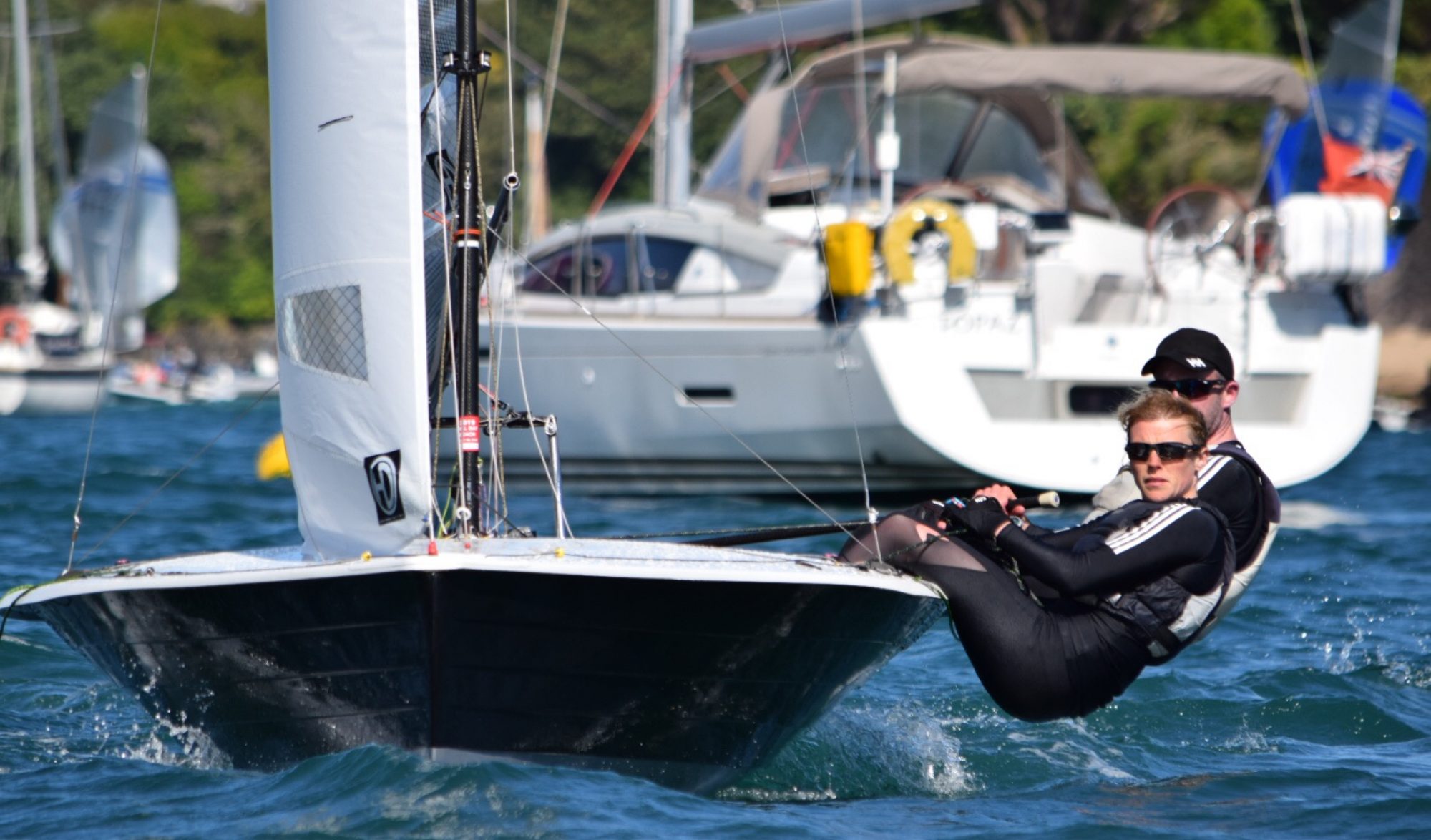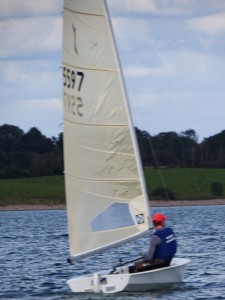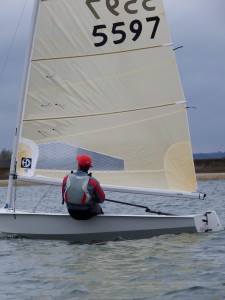After the 2014 season I felt it was time to try some changes to the Solo. We had been closely watching the Finn fleet since the 2012 games and the Golden sails that were being used certainly caught our eye.
Last winter I spoke with Dave Winder and decided to buy two Mk2 bare hulls and fit them out myself. I wanted set one up with standard kit (Complete Winder boat with HD Radial Laminate mainsail) and the other with modifications. This way I could get a real understanding by two boat tuning of what was working and what wasn’t.
The first idea was the sail. I had noticed over the last fews years, the growing number of Gold looking sails in the Finn fleet and decided to do a bit more research. These sails are built by a company in Finland and the general consensus was they were very quick in the light to medium airs and also lasted better than the Black Technora sails we use.
The laminate is called Maxx and is made from Kevlar, hence the golden look. It is stronger than Technora but doesn’t have the flex like the Technora yarn. When comparing the weight of the two cloths, the Maxx cloth is slightly heavier. This, along with the yarn being stronger is the reason why Finn sailors are finding it to be longer lasting.
The fibres in Maxx cloth are laid at varying angles, so that the sail forces are distributed evenly over the cross-cut panels. The result is superior longevity and control of the sail profile over a wide range of wind conditions.
The Maxx cloth was looking like the way to go. Not only did it look different and stand out, but I can build a smooth crosscut mainsail with less seams than a radial and more accuracy in the shape. We called Contender, who make the Maxx to discuss our idea. We needed to be sure that the cloth would work for the Solo, as it was produced specifically for Finn sails.
The data from the Maxx cloth showed it would be a reliable, versatile cloth. We could make a more powerful sail than the radial sail, that would be more responsive and easier to control and depower when needed.
Shape wise, we decided to start with a similar overall depth to the radial, sail as this was a good proven starting point.
The first event was the Winter Championships at Chew Valley. I was excited about trialling my new sail and having a new boat that I had fitted out myself. At Chew I found that I had an edge in the light airs. Exactly what I’d been looking for. Even though I led every race it, didn’t go my way and I finished on the same points as Pete Mitchell.
Next up was the Spring Championships at Draycote. Finally the weather forecast was looking a little better and I could use the sail in a bit more breeze. I didn’t have a good windward mark rounding as I was being more conservative on the start line. I did however find some really good pace and sailed through into the lead. When the wind dropped I seemed to get further away. Again, I managed to be consistent and win the Spring Champs.
On reflection I came away from Draycote still wanting more. I felt a bit vulnerable in the just hiking conditions and thought that I was lacking in power, so I decided to make the next sail fuller.
Off to the Welsh Nationals at the end of May with the next version of my Solo sail and a prodder kicker. The Saturday was light and there were some tricky conditions with big shifts. Straight away the setup felt great, I was certainly hiking sooner and matching the light weights off wind.
Sunday arrived with a force 4-5 and some great surf. A great opportunity for some heavy weather practice. I struggled to windward but was ballistic off wind. Upwind the boat felt unresponsive, it was hard to steer over the waves and I was using a lot of mainsheet. It didn’t feel right. I’d over cooked making the sail fuller, but I was also asking questions as to whether the prodder kicker was working correctly and was it working against me? Thankfully we had leeward finishes all weekend, and I managed to scrape by and take the win.
Back to the drawing board again and this time making steps to go in between where I had come from, to where I was now.
It was only a couple of weeks until I was going to the Scottish Solo Nationals at North Berwick and I had some pre-planned training with some of the Scottish lads a few days before the event. Robbie Wilson and I had a day two boat tuning. We used a variety of kit, swapped boats and noted down what we found out. We were both convinced that the Maxx sail was the way to go and with the latest change were very close. Maybe still a bit too full in the base though. Unfortunately the Scottish Nationals was blown off and postponed to September.
After the Scotland trip I sent Gordan Barclay some pictures of my Prodder kicker just so that I was clear that all was ok before heading to the Nationals. My kicker was pretty much the same as Gordan’s. I had an extra purchase system running from the end of the prodder to the goose neck. This enabled me to control the amount of forward movement that the kicker produces. I chose to go for this system so I could sail with a straighter mast whilst reaching and generate more power.
The Nationals were looming and time in the boat was short. I only had a few Wednesday evenings at Blithfield that I could practice and finalise the sail shape. It was only small changes now and a matter of getting used to the sail.
During the first 6 months I had received a lot of interest in the sail. But it wasn’t until the beginning of July, when I was happy with the design that I decided to let some out of the loft.
Beginning of August, North Berwick arrived and I was feeling unsure how it was all going to pan out. I hadn’t sailed against anybody since the training in June.
1st day out and all seemed fine, I didn’t feel particularly quick, just holding my own. The course felt one sided due to tide so it was a bit ‘follow my leader’ and not much chance for passing.
2 days off followed, which was nice, and then we managed to get three races in on the Wednesday. We had all sorts of weather, but it was mainly shifty. The boat felt great and I had plenty of speed upwind and down, I also led the last race, but again being conservative upwind didn’t pay. A large right shift came through on the inside of me and I managed to get a few boats back down the last run, having the best day out of everyone with two firsts and a sixth. Wednesday certainly gave me a confidence booster as I was able to sail away from some of my opposition, purely on straight line speed.
As the wind increased through out the week, I found myself with plenty of boat speed, certainly off wind on the reaches, but I gave myself too much work to do at the windward mark. I can certainly hold my hands up and say that my downfall at the nationals was my starting and first beat. I struggled to start and get off the line cleanly every race on the Thursday. Charlie was rounding the windward mark 1st every race and I was just about scraping in to the top 10. Thankfully my boat speed helped me out and by the end of the 35 minute races I was only a few boat lengths from Charlie at the finish. Three second places and again Charlie and myself were a long way ahead of the fleet.
Friday and the breeze was fairly light. My plan was to start near Charlie and try to make things uncomfortable, there were only 5 points in it and I had better discards. The only problem was we were both quicker and both ended up first and second. Still I had better discards, so it could go either way. The penultimate race we both put our discards in, a 14th for Charlie and a 20th for me. Down to the last race then.
A few general recalls on black flags, and one recall we were both certainly very close if not over, but two boats were caught just to windward of us so we were covered. The race got away and I’d like to think I made it uncomfortable for Charlie, but I’m sure that he would say otherwise. I didn’t do the job, but at the finish both of us failed to have guns so it left doubt in both our minds as to who had won. Any way it was congratulations to Charlie, he sailed a great series. I was actually very happy with the outcome. Yes it would be great to win but it was also nice to know that I felt I had upped my game as far as boat speed was concerned. I still need to put more hours in though, just to get my starting and first beats up to scratch.
A last minute decision to do the Scottish Nationals at the beginning of September, which were now being held at the home of golf, St. Andrews. Derek Gibb kindly lent me his boat thanks to the organisation of his brother, who we all know and love Kevan. St.Andrews is quite a tricky place to sail but with big waves we certainly had some fun, most of the weekend you could just hear Ian Hopwood howling down the reaches like a kid with a new bike!
I took my sail with me to use on Derek’s boat. We had good close racing but I managed to win all but one race and this was down to me sailing through the start and finish line downwind, which in Scotland is a no no. I would have done it again in the penultimate race but the very nice Mr Kevan Gibb shouted me not to go through it. I’ll blame the red wine on Saturday!
The weekend after the Scotland trip was the Solo Inlands at Grafham. The forecast was looking like a mixed bag, but we would certainly have some good breeze on the Saturday. Before the weekend started I had an email from the RYA on Friday saying that my prodder kicker wasn’t legal, (I thought ‘ Great timing! Why has it taken this long for a response and why less than 24 hours before a big championship!? I had dialogue with Gordan at the Nationals and all seemed ok! What I didn’t know until after the event was that someone else had enquired about the legality of it.) At the time, I didn’t contest I just changed it and got on with the weekend.
Saturday appeared with some fruity conditions. After a few general recalls we started and in the windy conditions I certainly had a boat speed advantage upwind and downwind. Tight reaching seemed to show the most speed and I think the leech of the sail opens and closes much quicker than the radial sail.
Sunday was very light but I was feeling confident with my kit, all I had to be was consistent and make sure that I had two good results and the job was done. Thankfully we had to wait for wind and this meant we were only going to have two races so I just needed to get one result. Again, like at the nationals I had good boat speed in the light airs and managed to come away victorious.
Since supplying the sails to customers we’ve had an excellent response and great feedback. Every Championship after the Nationals I have delivered sails to the events and everyone who has put one up feels it has made a difference to their speed. As a sailmaker it’s a great to hear positive feedback. Usually when something is fast we rarely hear anything. The customer just goes away happy and our job is done. But with this sail customers have been more than happy to tell us how great its’s been and that is fantastic.
The EOS at Oxford was good as boat speed was key, I seemed to carry on where I left off at Grafham. I slipped up half way up the first beat in the first race. I got on the wrong side of two shifts and found myself round the windward mark in the early teens. Before in light airs I thought there would be no way back, but I kept plugging away. I didn’t hit any corners up the beats, I just sailed for clear air and tacked when I felt a good shift. My boat speed did the work and I found my way slowly working through the fleet, to the front. After lunch, in the second race, I had a better first beat and rounded first. This time I just made sure I kept myself between the mark and the next boat. What was great to see and really made my day was Bob Taylor with the sail we made to fit his Wavelength mast. During lunch I handed him his new sail and we set it up on his boat. Through out the second race Bob was sailing round and pushing for second and third place. The sail had an instant effect. A slight shift at the end of the last beat cost Bob, but he managed to finished fourth.
My conclusion for the year is that I’m delighted with the outcomes. The research and development paid off and I feel that we have something special. The comparison between the radial and the Maxx sail is they both have very good stability in keeping the leech straight but where I think the Maxx gains slightly is it’s ability to change shape. It isn’t as stable as a radial sail in the luff and I think this enables us to build the sail deeper, because it will distort more, it will flatten off for when it’s windy. I have certainly found a noticeable shape change when you start pulling controls.



